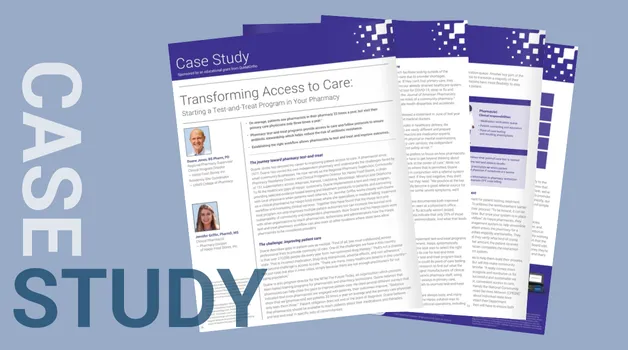- On average, patients see pharmacists in their pharmacy 33 times a year, but visit their primary care physicians only three times a year.1
- Pharmacy test-and-treat programs provide access to care and follow protocols to ensure antibiotic stewardship which helps reduce the risk of antibiotic resistance.
- Establishing the right workflow allows pharmacists to test and treat and improve outcomes.
THE JOURNEY TOWARD PHARMACY TEST-AND-TREAT
Duane Jones has devoted his career to improving patient access to care. A pharmacist since 1977, Duane has owned his own independent pharmacy and understands the challenges faced by small community businesses. He now serves as the Regional Pharmacy Supervisor, Community Pharmacy Residency Director and Clinical Programs Director for Harps Food Stores, a chain of 151 supermarkets across Arkansas, Kansas, Louisiana, Mississippi, Missouri and Oklahoma. To fill the healthcare gaps of Harps’ customers, Duane implemented a test-and-treat program, providing selected evidence-based testing and treatment protocols to patients, and partnering with local physicians when patients need referrals. Dr. Jennifer Griffin works closely with Duane as a clinical pharmacist for Harps food stores where she specializes in medical billing, treatment workflow and marketing clinical services. Together they have found that the Harps test-and- treat program not only improves multiple patient outcomes but can increase the survival and sustainability of community and independent pharmacies. Now Duane and his Harps team work with other organizations to teach pharmacists, technicians and administrators how the Harps test-and-treat pharmacy workflow can also work at other locations where state laws allow pharmacists to be considered providers.
THE CHALLENGE: IMPROVING PATIENT CARE
Duane describes gaps in patient care as twofold. “First of all, [we must collaborate] across professional lines to provide continuity of care. One of the challenges we have in this country is that over 270,000 people die every year from non-optimized drug therapy.2 That’s not a disease state. That is incorrect medication, drug-drug interactions, adverse effects, and non-adherence.” The second challenge is access to care. “There are many, many healthcare deserts in this country—not just rural, but also in inner cities, simply because there are not enough practitioners for our aging population.”
Duane is also program director for the MTM The Future Today, an organization which provides team-based training programs for pharmacists and pharmacy technicians. Duane believes that pharmacies can help close the gaps to improve patient care. He cited several different surveys that indicated that once pharmacists are engaged with patients, their outcomes improve. “Statistics show that we [pharmacists] see patients 33 times a year on average and the primary care physician only sees them three.”1 Patient obligation does not end at the point of diagnosis. Duane believes that pharmacists should be available to teach patients about their medications and therapies, and test-and-treat in specific sets of circumstances.
THE SOLUTION: TEST-AND-TREAT OUTSIDE OF PRIMARY CARE
New technologies are providing user-friendly options which facilitate testing outside of the laboratory or clinic. Many patients have limited access to care due to provider shortages, transportation issues, lack of health insurance, or expense. If they can’t find primary care, they may wind up in the emergency department—which burdens our already strained healthcare system. Conversely, patients can walk into their local pharmacy and test for COVID-19, strep or flu and receive treatment. According to a 2022 study published in the Journal of American Pharmacists Association, approximately 89% of Americans live within five miles of a community pharmacy.3 This situates pharmacies as local resources to help eliminate health disparities and accelerate public health initiatives.
Not everyone agrees. The American Medical Association released a statement in June of last year coming out against expanding test-and-treat policies beyond medical doctors.
“While pharmacists and physicians each play important roles in healthcare delivery, the length, breadth, and focus of their education and training are vastly different and prepare them for separate and distinct roles in patient care. Pharmacists are medication experts, but their clinical training does not prepare them to perform physical or mental examinations, diagnose patients, interpret test results, or provide primary care services; the independent practice of medicine by pharmacists puts patient health and safety at risk.”4
Rather than getting involved in polarizing conversations, Duane prefers to focus on how pharmacists can collaborate with healthcare professionals nationwide. “We have to get beyond thinking about self-preservation and have to think about putting the patient back at the center of care.” While not all states permit pharmacists to test and treat patients, in states where that is permitted, Duane recommends that these programs be protocol driven and used in conjunction with a referral system for local physicians. At Harps, a dichotomous decision tree is used: If they test negative, they don’t treat. If they test positive, the patient receives the proper care that they need. “We practice at the top of our license on behalf of the patient,” insists Duane. “We actually become a great referral source for physicians because if the patient tests negative, but they still have some severe symptoms, we’ll refer them on to their physician for care.”
Because the test-and-treat protocols are evidence-based, they have documented both improved outcomes and antibiotic stewardship. Duane elaborates that when seen at a physician’s office… “Statistics show that about 52% of the patients that are treated for flu actually weren’t tested
They were empirically treated with antiviral medication. In fact, data indicate that only 25% of those patients tested positive.5 So we’re overprescribing antibiotics and antimicrobials. And what that leads to is resistant strains that can potentially become life-threatening.”
A LITTLE HELP FROM OUR FRIENDS
There are several barriers that exist for pharmacists to be able to implement test-and-treat programs to improve patient care, namely test availability, time and reimbursement. Harps systematically addressed all three during the creation of their pilot program. First, the task was to select the right assay for their pharmacies. There are lots of point-of-care platforms to use for test-and-treat. Duane chose QuidelOrtho assays. He explained why: “We started our test-and-treat program back years ago when state laws were silent on whether or not pharmacists could do point-of-care testing. We wanted to make sure that we had the best system and did some research to find out what the clinics were using. We went with Quidel.” QuidelOrtho is one of the largest manufacturers of clinical testing equipment in the United States and their specialists trained Duane’s pharmacy staff, using the same protocols with the same hardware as found in point-of-care assays in primary care, urgent care or a hospital settings. They also created marketing materials to promote test-and-treat at pharmacy sites.
Next, Harps pharmacists had to tackle time constraints. Pharmacists are always busy, and many don’t have the time to provide enhanced clinical services to patients. The Harps solution was to institute a workflow that put pharmacy technicians in charge of all non-clinical operations, including data entry, product dispensing, and managing the adjudication queue. Another key part of the workflow is medication synchronization that allowed Harps to transition a majority of their prescription workload from acute to scheduled, so pharmacists have more flexibility to step away from the verification queue when they need to see a patient.
TEST-AND-TREAT
| Roles | |
| Pharmacy Technician: Non-clinical responsibilities • Data entry • Product dispensing • Manage adjudication queue • Input medication synchronization for new prescriptions | Pharmacist: Clinical responsibilities • Medication verification queue • Patient counseling and education • Point-of-care testing and resulting prescriptions |
| Workflow | |
| • Verifies insurance eligibility and benefits • Ensures insurance is active • Handles payment • Bills appropriate CPT code in pharmacy management system | • Determines what point-of-care test is needed • Performs test and obtains results • Writes prescription or refers patient to local physician if symptoms are severe • Returns information to pharmacy technician for appropriate CPT code billing |
PROMOTING PHARMACY SUSTAINABILITY THROUGH REIMBURSEMENT
For many pharmacies, billing and obtaining insurance reimbursement for patient testing, treatment and counseling can be very time consuming and frankly onerous. To address the reimbursement barrier at Harps, Jennifer has streamlined reimbursement and explained their process: “To be honest, it can be time consuming on the front end when you’re developing your process. But once your system is in place and your team is trained, it becomes a smooth and sustainable workflow.” At Harps pharmacies, they discovered a way to bill medical claims through their pharmacy management system to help streamline the claim creation and submission process. In a nutshell: When a patient enters the pharmacy for a test-and-treat service, a technician takes their insurance card and verifies eligibility and benefits. They make sure the patient’s insurance is active on the date of service and they verify what kind of copay deductible or co-insurance the patient may have. Then they collect that amount, the patient receives the service, and the patient is on their way to feeling better. The technician completes the interaction when they bill the appropriate CPT code in the pharmacy management system.
Duane and Jennifer want to share this workflow with other pharmacies to help them build their process, empower their staff, and make reimbursements totally manageable. But will this make community and independent pharmacies more sustainable? “Yes!” according to Jennifer. “It really comes down to getting more payers on board. The more payers that we have that recognize and reimburse us for the value of these services offered in the pharmacy setting, the more successful and sustainable we will be.” This workflow is described as win-win. The patients receive fast, convenient access to care, and pharmacy viability and sustainability are supported. Duane recommends the National Community Pharmacists Association (NCPA)6 and the Community Pharmacy Enhanced Services Network (CPESN)7 for resources on implementing test-and-treat programs and to find out about individual state laws governing pharmacists and reimbursement. Pharmacies will have to contact their Department of Health to inquire about reporting requirements and CLIA waiver, and then will have to ensure both the pharmacist and pharmacy are credentialed by the various payers.
STEPS FOR TEST-AND-TREAT IMPLEMENTATION
- Evaluate resources for implementation in your state
- NCPA
- CPESN
- Contact the Department of Health in your state
- CLIA waiver
- Reporting requirements
- Credential pharmacists AND pharmacy with payers
- Different payers have different requirements
- Establish clinical protocols for testing, treatment and physician referral
- Implement workflow to provide pharmacists flexibility to see patients
- Train pharmacy technicians on all non-clinical tasks and medical billing
- Utilize medication synchronization
WILL PATIENTS ADOPT?
The best way to encourage patients to use pharmacy test-and-treat is to market directly to the patient. Jennifer agrees that this is a new concept for many people. Marketing is a process that they are still learning and evolving. She explains, “Since starting our test-and-treat program, we’ve created bag stuffers and added eye-catching signage inside each pharmacy. We actively promote our services on Facebook and Instagram where our audience continues to grow. But honestly, our most effective marketing is word of mouth. Once patients experience how convenient and simple the process is, they tend to tell other people.”
THE FINAL RESULT
Duane has, over many years, collected test-and-treat data from the Harps working pharmacies. He has partnered with Elevance Health Inc., an American for-profit health insurance provider, and CPESN, who together have collaborated to publish studies reporting that pharmacy intervention in medication therapy saved 35% in hospital visits and 15% in emergency visits.8 He is presently working with other organizations to provide more health economic data. He and his team feel certain that the data will show more cost savings. He explains it this way, “The [insurance] plans will get on board with compensating for these [pharmacy test-and-treat] services because they see how much money they’re going to save. For us, our win is a healthy patient. That’s why I get out of bed every morning and that’s why I’m so passionate about what we’re doing.”
- How Community Pharmacies Enable Health Plans to Measurably Improve Adherence and Quality Measures. EnlivenHealth. Published October 29, 2020. Accessed May 27, 2025. https://enlivenhealth.co/blog/power-ofcommunity-pharmacies-to-improve-adherence-and-quality-measures/
- New Analysis Suggests Adverse Drug Events Are the 3rd Leading Cause of Death in the USA. Practicalneurology.com. Published March 26, 2025. Accessed June 9, 2025. https://practicalneurology.com/news/new-analysis-suggest-adverse-drug-events-are-the-3rd-leading-cause-of-deathin-the-usa/2473820/
- Berenbrok LA, Tang S, Gabriel N, et al. Access to community pharmacies: A nationwide geographic information systems cross-sectional analysis. J Am Pharm Assoc. 2022;62(6):1816-1822.e2.
- Leadership. American Medical Association. Published June 18, 2025. Accessed May 27, 2025. https://www.amaassn.org/about/leadership.
- Klepser DG, Corn CE, Schmidt M, Dering-Anderson AM, Klepser ME. Health Care Resource Utilization and Costs for Influenza-like Illness Among Midwestern Health Plan Members. J Manag Care Spec Pharm. 2015;21(7):568-73.
- NCPA – National Community Pharmacists Association. Accessed May 27, 2025. https://ncpa.org
- Community Pharmacy Enhanced Services Network CPESN. Cpesn.com. Accessed May 27, 2025. https://cpesn.com
- Healthcare Innovation Caucus – Role of CP in VBPM 2018. www.nacds.org. Accessed 27 May 2025.





